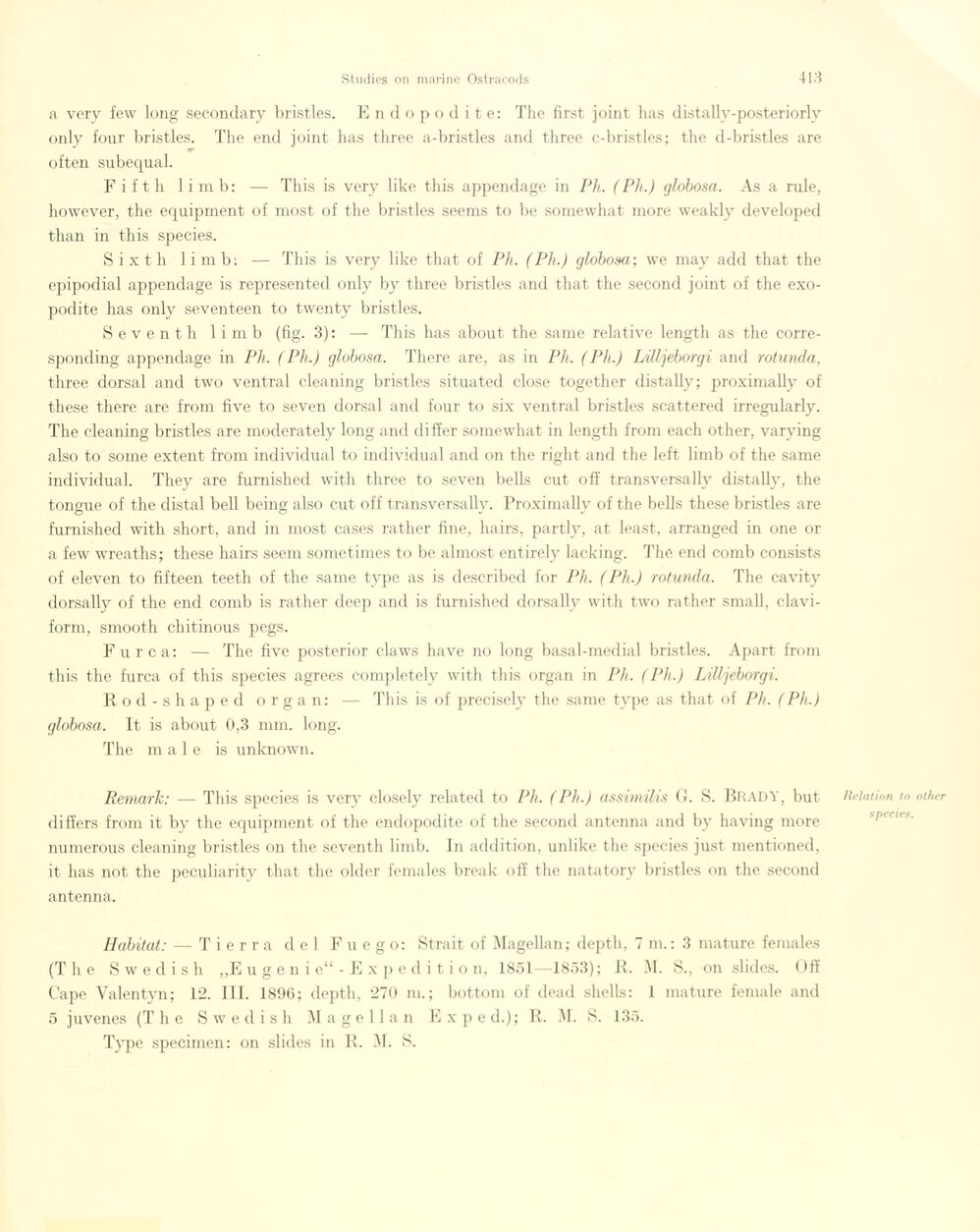
Full resolution (JPEG) - On this page / på denna sida - Sidor ...

<< prev. page << föreg. sida << >> nästa sida >> next page >>
Below is the raw OCR text
from the above scanned image.
Do you see an error? Proofread the page now!
Här nedan syns maskintolkade texten från faksimilbilden ovan.
Ser du något fel? Korrekturläs sidan nu!
This page has never been proofread. / Denna sida har aldrig korrekturlästs.
a very few long secondary bristles. Endopodite: The first joint lias distally-posteriorly
only four bristles. The end joint has three a-bristles and three c-bristles; the d-bristles are
often subequal.
Fifth limb: — This is very like this appendage in Ph. ( Pli.) globosa. As a rule,
however, the equipment of most of the bristles seems to be somewhat more weakly developed
than in this species.
S i X t h lim b: — This is very like that of Pk. (Ph.) globosa; we may add that the
epipodial appendage is represented only by three bristles and that the second joint of the
exo-podite has only seventeen to tvventy bristles.
Seventh limb (fig. 3): — This has about the same relative length as the
corre-sponding appendage in Ph. (Ph.) globosa. There are, as in Ph. (Ph.) LiUjéborgi and rotunda,
three dorsal and two ventral cleaning bristles situated close together distally; proximally of
these tliere are from five to seven dorsal and four to six ventral bristles scattered irregularly.
The cleaning bristles are moderately long and differ somewhat in length from each other, varying
also to some extent from individual to individual and on the right and the left limb of the same
individual. They are furnished with three to seven belis eut off transversally distally, the
tongue of the distal bell being also eut off transversally. Proximally of the bells these bristles are
furnished with short, and in most cases rather fine, hairs, partly, at least, arranged in one or
a few wreaths; these hairs seem sometimes to be almost entirely lacking. The end comb consists
of eleven to fifteen teeth of the same type as is described for Ph. (Ph.) rotunda. The cavity
dorsally of the end comb is rather deep and is furnished dorsally with two rather small,
clavi-form, smooth chitinous pegs.
Furca: — The five posterior claws have no long basal-medial bristles. Apart from
this the furca of this species agrees completely with this organ in Ph. (Ph.) Lilljeborgi.
R o d - s h a p e d organ: — This is of precisely the same type as that of Ph. (Ph.)
globosa. It is about 0,3 mm. long.
The male is unknown.
Remark: — This species is very closely related to Ph. (Ph.) assimilis G. S. Brady, but
differs from it by the equipment of the endopodite of the second antenna and by having more
numerous cleaning bristles on the seventh limb. In addition, unlike the species just mentioned,
it has not the peculiarity that the older females break off the natatory bristles on the second
antenna.
Habitat: — T i e r r a del F u e g o: Strait of Magellan; depth, 7 m. : 3 mature females
(The Swedish „E u g e n i e“ - E x p e d i t i o n, 1851—1853); R. M. S., on slides. Off
Cape Valentyn; 12. III. 1896; depth, 270 m.; bottom of dead shells: 1 mature female and
5 juvenes (The Swedish Magellan Exped.); R. .M. S. 135.
Type specimen: on slides in R. M. S.
<< prev. page << föreg. sida << >> nästa sida >> next page >>